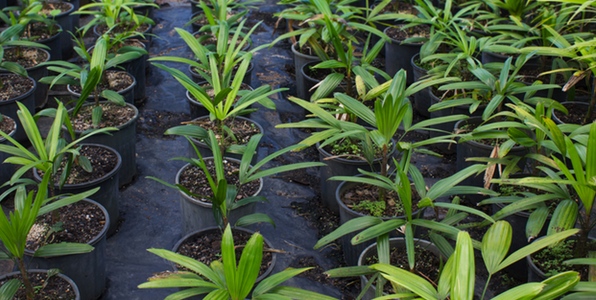Jump to page 2 | 3 | 4 | 5 | 6 | 7 | 8 |
Palms:Sun, Water and Soil
Sunlight
Some palms prefer to be under the shade while others welcome the heat. Palms like the Alexandra and the Foxtail like full sun from early age but do well in either condition. Cascades (Chamaedorea cataractarum) and Australia Fans (Licularis ramsayi) like some shade while Kentia's (Howea forsteriana) take time to adjust.
If you're planning to grow palms indoors, check for the types that do well with little sun exposure and can tolerate air-conditioning. The Kentia does well in these environments and can even withstand a little neglect, as do Lady Palms (Rhapis excelsa). Indoor palms benefit from being taken outside every few weeks to receive full sun in order to regain strength.
A guide to potting, planting and caring for your palm tree
Potting palms to some is an easy task. However, when dealing with such an intricate plant, it is important to have a set of steps to ensure optimal growth. The most important part of potting a palm is to know what species it comes from, the conditions that it requires for growth, and the level of maintenance needed to keep it healthy.
Certain aspects such as pot types, soil mixes, watering and fertilization, affect the patterns of growth of a palm, below is a guide to potting.
Palm Fertilizer and Best Practices
Palms achieve their best condition when they are taken care of properly. Likewise, they also appear their best when receive sufficient attention. It is important to learn the fundamentals of palm care to be able to bring out their ultimate capacities. One way to bring out the best in palms is through the use fertilizers. Fertilizers help enhance growth and make it possible for the plants to reach optimal condition.
Nonetheless, it is essential to understand that while fertilizers are generally good for palms they can also be damaging if not applied properly. There are general procedures for applying fertilizer regardless of the plant type. However, it will also do the grower well if they can learn more about fertilization application specific to their species.
Palm Pollination in a Nutshell
Pollination is how most, if not all plants and flowers propagate. It is essential in making sure that the world's foliage is able to maintain the delicate balance of the eco system.
Palms also undergo the same process of propagation. Palms are plants that flower enabling them to reproduce through the pollen of the flowers. Different palms have different flowers and vary in appearance and size but the basic procedure is relatively similar for all. Palms produce flowers at different times in their life span, depending on the variety. Some palms flower very rarely and some more frequently. There are even palms that flower near the end of their life like the Fishtail Palms. In this case, the optimum time in which pollination should happen differs from palm to palm.
Palms: Solving Brown Tips and Leaf Problems
Planted palms are generally very easy to maintain. They require little effort and only sufficient tender loving care. Some things to take care of include soil condition, leaf problems and brown tips.
Natural Browning
Before trying to solve browning in palms it is important to understand why palms go through a browning process. Basically, browning tips are natural. Palms produce new leaves throughout their growing period. As the plant reaches the end of its growth or life, its tips will start browning until it completely dries and then drops from the body of the plant. However, there are instances wherein browning is not just a natural occurrence.
Madagascar, an Island of Palms
Madagascar is a "garden of Eden" for bio-diversity. It is home to 10,000 plant species, 90% are found nowhere else in the world. It is the 4th largest island in the world, situated off the east coast of Africa slightly below the equator. In Australia the same latitude is from just above Brisbane to Cape York .It is 1580 km's long and 570 km's wide and has 6 different microclimates. The highest mountain is 2876 metres and a steep mountain range parallels the entire east coast.
Madagascar broke off from Gondwana 160 million years ago and then broke away from India 80 million years ago. It has an eastern and south-central rainforest area, a western dry forests area and a southern desert area.





